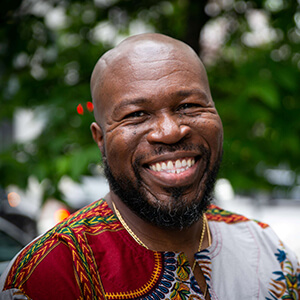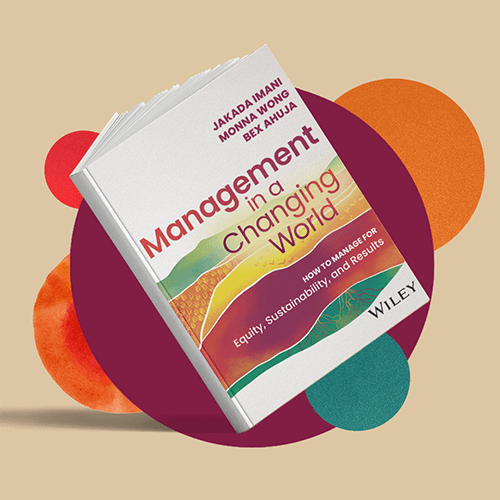If you’ve been in the nonprofit sector for a while, it’s likely one of the books you’ve read on nonprofit management is Managing to Change the World from The Management Center (TMC). Published in 2009, it taught the fundamentals of effective nonprofit management—during a much different time.
The fundamentals are still there in TMC’s new book Management in a Changing World, yet the authors—TMC’s CEO Jakada Imani, Chief Content Officer Monna Wong, and Bex Ahuja, former managing partner of TMC’s training team and now managing director at Rockwood Leadership Institute—recognized early on it couldn’t just be an update. “In the last book, equity and sustainability is a sidebar,” Imani says. “If you are a person of color, an immigrant, a nonbinary person, you might have [read the first book] in a way that wasn’t talking to you.”
“The [original] instructional manual on management,” Ahuja adds, “didn’t consider what it means to manage as people of color who are often targets of the exact systems of oppression that our organizations are fighting against. Not approaching the book with this lens could really cause harm, and it’s out of responsibility that we had to write a new book.”
Bridgespan Group Partner Meera Chary recently talked with the authors, learning about the motivations and experiences that guided their work and the management approaches that most resonate with them as leaders.
Meera Chary: You start the book with the mention of power—while the notion of “power” is implicit in management, many people don’t intentionally use those two words together. Why did you choose to start the book with the notion and acknowledgment of power?
 Jakada Imani
Jakada ImaniJakada Imani: There are a number of reasons, but the one I will call out here is, in a hierarchical organization, people who are in a position of power are more responsible for the experience, the structures, the outcomes, for everything in the organization. And in this day and age, we thought it was important to name it and put people on the hook to be responsible for it. In coaching and training, I say that this is a sacred vocation—people are giving you something that they can’t get back, which is their time and their life force. We wanted to name that there is a kind of power that you have in people's lives that you shouldn’t, as a manager, take lightly. Managers should sit with this in a way that can make a difference in someone’s life in a positive way, in their success, and in their careers.
The “conspire and align” approach to management comes up throughout the book. What does it mean? And how does this play out in a nonprofit organization?
Imani: At TMC, one of the things that I did when I stepped into leadership was to name for everyone that we were going from a white-founded, white-led organization to being a multiracial, Black-led organization. And we would have to do some work to get clear because we weren’t a Black organization, a Latinx organization, an API organization, an immigrant organization, or an LGTBQI organization. And there are times when things feel off. Does this feel off because we have a standard of white supremacy, or is it off because I’m bringing a Black approach to this and someone else is bringing an Indigenous approach?
One example of this: We had a staff meeting where someone brought up the notion of decolonizing something we were working on. An Indigenous team member called out that when we talk about decolonizing and we’re not centering giving Indigenous lands back, that feels off-base as an Indigenous person. And then another person raised their hand and said, “I am an immigrant and my people have been Indigenous to the Caribbean for generations, and we use the word ‘decolonization’ to mean this.” We had a moment of breaking open that conversation where people were able to be more of themselves. Folks could talk about it, struggle with it, hear and see each other in it as part of building a multiracial organization that didn’t paper over the fact that there will still be discomfort, and that discomfort won’t necessarily be because we’re centering white supremacy but [because] we’re trying to figure out collectively how do we not. That’s the idea of “conspire and align.”
 Monna Wong
Monna WongFor TMC, that’s being clear about where we’re going together, which is towards an inclusive multiracial organization, and that we can question and should question things that feel off-base, out of alignment, or outside of our values. I had to paint a clear picture and get alignment on the culture we’re trying to create. We are a community of purpose. It’s not that we’re building relationships just because we like each other; we’re building relationships because we’re going somewhere together, and this helps us get aligned and re-aligned and allows people to bring more and more of themselves into it.
Monna Wong: Right—for TMC, it was an honest, open conversation where folks were really bringing parts of themselves that, in other places, they might not have felt comfortable bringing. It’s called “conspire and align,” not “conspire and agree”—it was about bringing in the value of seeking perspective, so we could inform how we show up with each other. That is how the conversation, to me, embodied a conspire and align approach.
Bex Ahuja: To me, conspire and align also is an alternative to an individualist mindset. Often some issue [at Rockwood] might suddenly come up, and a go-getter employee wants to solve it off by themselves. I step in and say ‘Hey, let’s slow down to talk about it and make sure we’re including who we need to include’—not because I want to control, but because that issue likely impacts others around them. It’s counterintuitive but taking this step to align on what we’re trying to do allows us to be more nimble even as our organization is growing in size.
Where should managers start in reading this book?
Imani: We don’t expect people to read cover to cover. We expect people to pick it up and go to it when they need something. [We] had to remind ourselves that is how most practitioners are going to read it because they have a job that takes a bunch of their time. But, if you’re looking for a place to start, whether you’re a new manager or a seasoned manager, I would start at the beginning, the stuff that we put there as the foundation.
 Bex Ahuja
Bex AhujaWong: We put chapter 1 first for a reason. Those are the fundamentals. No matter where you are in your career, or your experience as a manager, the information in chapter 1 will apply.
Relationship building is the second chapter. Given that management is a practice, you also have to understand the context in which you are practicing and part of that means understanding that everyone is different. There are people I have managed, and they get in and they want to know “What are my goals?” and that’s enough for them. And then there are people who want to feel immediately that you care about them as a person—you need to develop a relationship with them first. Meeting folks where they are is part of the practice of management that is really important.
Ahuja: You’re right, Monna. The relationship-building piece is so baked into my programming that I often forget to talk about it. Before anything else, I need to understand how you orient yourself to this work, so I have context for how I am going to orient myself to you and how you are going to orient yourself to me.
What would you want funders to know about management practice as it relates to themselves or how they support the nonprofits and leaders in their ecosystems?
Imani: That [management] is a value-centered practice and people can get better at it. There are very few natural-born managers, and that’s okay. It’s a human skill about human relations that most people can get better at. Keep practicing and keep beginning again.
Ahuja: Managers are going to make mistakes. They should have room to do so—and they owe it to the work and their teams to be able to genuinely apologize and learn. That’s it.



